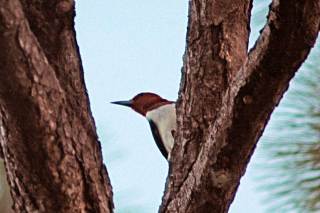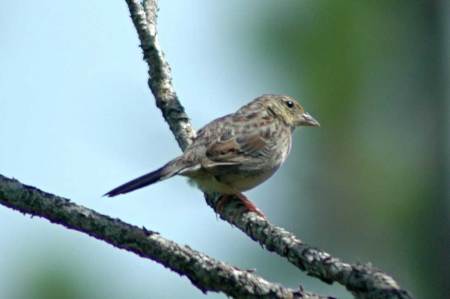Every third Saturday in September is the fall version of the North American Migration Count. Birders around the country go out in teams to try to count every bird in the county. In a county as big as Palm Beach County, that’s a lot of territory to cover (+/- 2,000 square miles!). I was assigned to cover about 60,000 acres of it, known as JW Corbett Wildlife Management Area. I went in the company of one of the biologists who works there, which is very important since much of Corbett is underwater this time of year. But when you’re working with Mike, you have access to one of the FWC’s giant swamp buggies, and that that enables you to reach, well, just about anywhere you need to go on the site.
It was a hot Saturday, like many Saturdays in September in south Florida. We started early and as a good way to start the day we managed to find the Red-headed Woodpecker family at their tree (my first Palm Beach County sighting of this common North American woodpecker):
The site encompasses an enormous range of habitat types, because (a) it’s large, and (b) it’s in a transition zone from the central Florida upland type habitat to the south Florida Everglades community. So it has your typical hardwood hammocks, pine flatwoods, and mesic hardwood hammocks of central Florida, along with the marshes, cypress sloughs, and cypress domes that you’ll find in our area. It’s so large that, even though we were in the field from 8 a.m. to 2 p.m. we only covered about a quarter of the site.
We were thinking that it would take at least 3 teams of 3 people armed with scopes and swamp buggies to really cover the area well. But that would take a lot of birders away from other areas in Palm Beach County; there just isn’t a way to cover the entire county with the number of birders we have.
Throughout the day we found the birds a bit scarce, but we did manage to find a few of them. We hit some resident species like Bachman’s Sparrow:
But missed others, like Red-cockaded Woodpecker. (Mike went back later to get it, as there is a large resident population, and it would have been silly not to have it for the count.)
We found a few migrants as well: two tanager species (summer and scarlet), ten warblers (including my first ever Mourning Warbler, better view desired), a couple of flycatchers (one that was quite intriguing, but probably was just a Great-crested like the others we saw). The complete list of birds found appears below the gallery at the bottom of the post.
We found some other wildlife as well (treefrogs, dragonflies galore, butterflies), as you can see in the gallery:
Hope you enjoyed your time in the field, if you made it into the field; in the backyard, if you made it that far; indoors, if that’s all you could manage. (And if so, I know exactly how you feel! Many’s the day I barely even make it out the door, with all my indoor responsibilities.)
| Common Name | Genus | Specific epithet | Individuals recorded |
|---|---|---|---|
| Anhinga | Anhinga | anhinga | 9 |
| Great Blue Heron | Ardea | herodias | 1 |
| Great Egret | Ardea | alba | 1 |
| Tricolored Heron | Egretta | tricolor | 6 |
| Little Blue Heron | Egretta | caerulea | 1 |
| Green Heron | Butorides | virescens | 2 |
| American Bittern | Botaurus | lentiginosus | 1 |
| White Ibis | Eudocimus | albus | 11 |
| Mottled Duck | Anas | fulvigula | 4 |
| Black Vulture | Coragyps | atratus | 12 |
| Turkey Vulture | Cathartes | aura | 3 |
| Osprey | Pandion | haliaetus | 1 |
| Red-shouldered Hawk | Buteo | lineatus | 6 |
| Rock Pigeon | Columba | livia | 2 |
| Mourning Dove | Zenaida | macroura | 8 |
| Common Ground-Dove | Columbina | passerina | 5 |
| Belted Kingfisher | Ceryle | alcyon | 4 |
| Red-headed Woodpecker | Melanerpes | erythrocephalus | 3 |
| Red-bellied Woodpecker | Melanerpes | carolinus | 11 |
| Downy Woodpecker | Picoides | pubescens | 10 |
| Pileated Woodpecker | Dryocopus | pileatus | 7 |
| Great Crested Flycatcher | Myiarchus | crinitus | 3 |
| Barn Swallow | Hirundo | rustica | 6 |
| Carolina Wren | Thryothorus | ludovicianus | 4 |
| Northern Mockingbird | Mimus | polyglottos | 9 |
| Brown Thrasher | Toxostoma | rufum | 2 |
| Blue-gray Gnatcatcher | Polioptila | caerulea | 18 |
| Blue Jay | Cyanocitta | cristata | 13 |
| White-eyed Vireo | Vireo | griseus | 9 |
| Northern Parula | Parula | americana | 2 |
| Black-throated Blue Warbler | Dendroica | caerulescens | 4 |
| Yellow-throated Warbler | Dendroica | dominica | 2 |
| Pine Warbler | Dendroica | pinus | 8 |
| Prairie Warbler | Dendroica | discolor | 6 |
| Black-and-white Warbler | Mniotilta | varia | 4 |
| American Redstart | Setophaga | ruticilla | 15 |
| Worm-eating Warbler | Helmitheros | vermivorus | 3 |
| Ovenbird | Seiurus | aurocapilla | 4 |
| Mourning Warbler | Oporornis | philadelphia | 1 |
| Common Yellowthroat | Geothlypis | trichas | 2 |
| Scarlet Tanager | Piranga | olivacea | 1 |
| Summer Tanager | Piranga | rubra | 2 |
| Bachman's Sparrow | Aimophila | aestivalis | 1 |
| Northern Cardinal | Cardinalis | cardinalis | 17 |
| Eastern Meadowlark | Sturnella | magna | 1 |
| Common Grackle | Quiscalus | quiscula | 7 |








